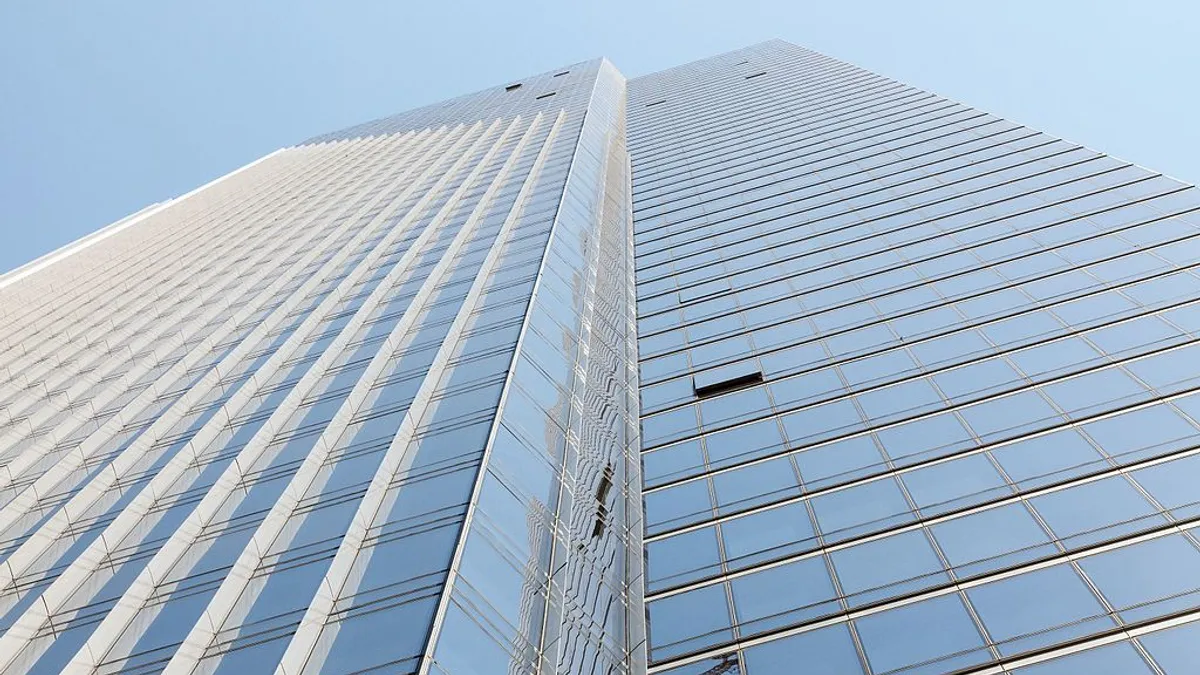UPDATE: October 19, 2018: In an Oct. 2 letter to the city and county of San Francisco's Department of Building Inspection, Howard Dickstein, president of the center association board of directors for the Millennium Tower Association, informed officials that the cracked window in a 36th floor unit was due to "exterior impact," not from the building's settlement. NBC Bay Area obtained a copy of the letter.
Architectural engineering firm Allana Buick & Bers conducted the investigation and also determined that the area was clear of broken glass, that there was no need for a pedestrian protection system and that it found no reason to continue a structural investigation of the curtain wall assembly.
Because of the outcome of the expert study, Dickstein wrote that the association does not intend to perform a visual inspection of the rest of the building's windows.
Dickstein called the investigation's results "the best possible outcome for our community and for public safety."
Dive Brief:
- Cracks in a window at the 36th floor of the beleaguered Millennium Tower in San Francisco has launched a new round of inspections and engineering evaluations of the high-rise, which has been leaning and sinking since it opened in 2009, according to the San Francisco Chronicle.
- An architecturural engineering firm hired by the skyscraper's residents has yet to reach a conclusion as to the cause of the cracks, leaving open the possibility that it could be related to structural issues caused by the building's settling, a defect in the material or the result of an isolated event. Once someone from the company has rappelled down the side of the building, taped over the crack and performed an exterior inspection and evaluation, the firm will update the city's Department of Building Inspection (DBI). The Millennium's management sent residents an email in which it said its own experts determined that the cracks were not related to the structure's settlement and, instead, planned to examine window assembly and installation.
- The DBI sent management a letter on Sept. 12 requiring it to install an overhead protection system around the perimeter of the building by Sept. 13, repair a window washing crane in order to help inspectors examine the window from outside by Sept. 14 and complete a search for additional cracks or façade damage by Sept. 14. After pushback by management attorneys against the DBI's threat of a yellow-tag, which would limit access to the building, the DBI reportedly eased up on its deadlines and said it would give the Millennium organization more time to achieve the requirements.
Dive Insight:
The Millennium opened its doors to residents almost 10 years ago but could be undergoing major foundation work soon. Engineers hired to assess how the building could be kept from sinking more than the 18 inches it already has have come up with a $500 million plan to stabilize the structure by driving new piles into the bedrock underneath the building. The strategy, however, has drawn concern from residents as it would see one side anchored into bedrock first while the other side of the building is allowed to continue to settle until it is level, perhaps subjecting the structure to too much stress.
This incident with the cracks is not the first time the building's curtain wall has been subjected to scrutiny. In December, questions were raised about the tower's safety after a consulting firm hired by residents to trace the source of bad odors reported that the settlement had created gaps between the curtain wall and main structure. Aside from becoming a pathway for the odors in question, these spaces, according to the consultant, breached the tower's fire and smoke barrier. City inspectors then issued a fire safety risk violation citation against the Millennium, requiring it to either repair the problem or find a qualified third party to confirm that the building is safe.













